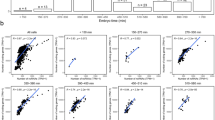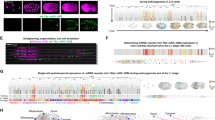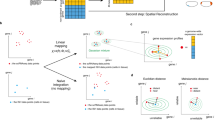Abstract
More than 10 megabases of contiguous genome sequence have been submitted to the databases by the Caenorhabditis elegans Genome Sequencing Consortium. To characterize the genes predicted from the sequence, we have developed high resolution FISH for visualization of mRNA distributions in whole animals. The high resolution and sensitivity afforded by the use of directly fluorescently labelled probes and confocal imaging permitted mRNA distributions to be recorded at the cellular and subcellular level. Expression patterns were obtained for 8 out of 10 genes in an initial test set of predicted gene sequences, indicating that FISH is an effective means of characterizing predicted genes in C. elegans.
This is a preview of subscription content, access via your institution
Access options
Subscribe to this journal
Receive 12 print issues and online access
$209.00 per year
only $17.42 per issue
Buy this article
- Purchase on SpringerLink
- Instant access to full article PDF
Prices may be subject to local taxes which are calculated during checkout
Similar content being viewed by others
References
Coulson, A., Sulston, J., Brenner, S. & Karn, J. Towards a physical map of the genome of the nematode Caenorhabditis elegans. Proc. natn. Acad. Sci. U.S.A. 83, 7821–7825 (1986).
Coulson, A., Waterston, R., Kiff, J., Sulston, J. & Kohara, Y. Genome linking with yeast artificial chromosomes. Nature 335, 184–186 (1988).
Sulston, J. et al. The C. elegans genome sequencing project: a beginning. Nature 356, 37–41 (1992).
Wilson, R.K. et al. 2.2 Mb of contiguous nucleotide sequence from chromosome III of C. elegans. Nature 368, 32–38 (1994).
Sulston, J.E. & Horvitz, H.R. Post-embryonic cell lineages of the nematode, Caenorhabditis elegans. Devl. Biol. 56, 110–156 (1977).
Kimble, J. & Hirsh, D. The postembryonic cell lineages of the hermaphrodite and male gonads in Caenorhabditis elegans. Devl. Biol. 70, 396–417 (1979).
Sulston, J.E., Albertson, D.G. & Thomson, J.N. The Caenorhabditis elegans male: postembryonic development of nongonadal sructures. Devl. Biol. 78, 542–676 (1980).
Sulston, J.E., Schierenberg, E., White, J.G. & Thomson, J.N. The embryonic cell lineage of the nematode Caenorhabditis elegans. Devl. Biol. 100, 64–119 (1983).
Hill, D.P. & Wurst, W. Gene and enhancer trapping: Mutagenic strategies for developmental studies. Curr. Topics dev. Biol. 28, 181–205 (1993).
Hope, I.A. “Promoter trapping” in Caenorhabditis elegans. Development 113, 399–408 (1991).
Lynch, A.S., Briggs, D. & Hope, I.A. Developmental expression pattern screen for genes predicted in the C. elegans genome sequencing project. Nature Genet. 11, 309–313 (1995).
Spieth, J., Brooke, G., Kuersten, S., Lea, K. & Blumenthal, T. Operons in C. elegans: polycistronic mRNA precursors are processed by trans-splicing of SL2 to downstream coding regions. Cell 73, 521–532 (1993).
Zorio, D.A.R., Cheng, N.N., Blumenthal, T. & Spieth, J. Operons as a common form of chromosomal organization in C. elegans. Nature 372, 270–572 (1994).
Lawence, J.B., Singer, R.H. & Marselle, L.M. Highly organized tracks of specific transcripts within interphase nuclei visualized by in situ hybridization. Cell 57, 493–502 (1989).
Dirks, R.W. van de Rijke, F.M., Fujishita, S., van der Ploeg, M. & Raap, A.K. Methodologies for specific intron and exon RNA localization in cultured cells by haptenized and fluorochromatized probes. J. Cell Sci. 104, 1187–1197 (1993).
MacPhee, D.J., Barr, K.J., DeSousa, P.A., Todd, S.D.L. & Kidder, G. Regulation of Na+, K+-ATPase subunit gene expression during mouse preimplantation development. Devl. Biol. 162, 259–266 (1994).
Chuang, P.-T., Albertson, D.G. & Meyer, B.J. DPY-27: a chromosome condensation protein homolog that regulates C. elegans dosage compensation through association with the X chromosome. Cell 79, 459–474 (1994).
Waterston, R.H., The Nematode, Caenorhabditis elegans. (ed. Wood, W.B.) 281–335 (Cold Spring Harbor, New York, 1988).
Kimble, J. & Sharrock, W.J. Tissue-specific synthesis of yolk proteins in Caenorhabditis elegans. Devl. Biol. 96, 189–196 (1983).
Schedin, P., Hunter, C.P. & Wood, W.B. Autonomy and nonautonomy of sex determination in triploid intersex mosaics of C. elegans. Development 112, 833–879 (1991).
Klass, M., Dow, B. & Herndon, M. Cell-specific transcriptional regulation of the major sperm protein from Caenorhabditis elegans. Devl. Biol. 93, 152–164 (1982).
Ward, S. & Klass, M. The location of the major protein in Caenorhabditis elegans sperm and spermatocytes. Devl. Biol. 92, 203–208 (1982).
Mitani, S., Du, H., Hall, D.H., Driscoll, M. & Chalfie, M. Combinatorial control of touch receptor neuron expression in Caenorhabditis elegans. Development 119, 773–783 (1993).
Wilhelm, J.E. & Vale, R.D. RNA on the move: the mRNA localization pathway. J. Cell Biol. 123, 269–274 (1993).
Okita, T.W., Li, X. & Roberts, M.W. Targeting of mRNAs to domains of the endoplasmic reticulum. Trends Cell Biol. 4, 91–95 (1994).
Fire, A., Albertson, D., Harrison, S.W. & Moerman, D.G. Production of antisense RNA leads to effective and specific inhibition of gene expression in C. elegans muscle. Development 113, 503–514 (1991).
Singh, R.N. & Sulston, J.E. Some observations on moulting in Caenorhabditis elegans. Nematlogia 24, 63–71 (1978).
Golden, J.W. & Riddle, D.L., The Caenorhabditis elegans dauer larva: developmental effects of pheromone, food, and temperature. Devl. Biol. 102, 368–378 (1984).
Ward, S., Thomson, N., White, J.G. & Brenner, S. Electron microscopical reconstruction of the anterior sensory anatomy of the nematode Caenorhabditis elegans. J. comp. Neur. 160, 313–338 (1975).
Ware, R.W., Clark, D., Crossland, K. & Russell, R.L. The nerve ring of the nematode Caenorhabditis elegans: sensory input and motor output. J. comp. Neur. 162, 71–110 (1975).
Albertson, D.G. & Thomson, J.N. The pharynx of Caenorhabditis elegans. Phil. Trans. R. Soc. B 275, 299–325 (1976).
White, J.G., Southgate, E., Thomson, J.N. & Brenner, S. The structure of the ventral nerve cord of Caenorhabditis elegans. Phil. Trans. R. Soc. B 275, 327–348 (1976).
White, J. The anatomy. In The Nematode, Caenorhabditis elegans. (ed. Wood, W.B.), 81–122 (Cold Spring Harbor, New York, 1988).
White, J.G., Southgate, E., Thomson, J.N. & Brenner, S. The structure of the nervous system of the nematode Caenorhabditis elegans. Phil. Trans. R. Soc. B 314, 1–340 (1986).
Ainger, K. et al. Transport and localization of exogenous myelin basic protein mRNA microinjected into oligodendrocytes. J. Cell Biol. 123, 431–441 (1993).
Steward, O. & Banker, G.A. Getting the message from the gene to the synapse: sorting and intracellular transport of RNA in neurons. TINS 15, 180–186 (1992).
Eddy, S.R. & Durbin, R. RNA sequence analysis using covariance models. Nucl. Acids Res. 22, 2079–2088 (1994).
Rosbach, M. & Singer, R.H. RNA travel: tracks from DNA to cytoplasm. Cell 75, 399–401 (1993).
Albertson, D.G. Mapping muscle protein genes by in situ hybridization using biotin-labelled probes. EMBO J. 4, 2493–2498 (1985).
Albertson, D.G., Fishpool, R., Sherrington, P., Nacheva, E. & Milstein, C. Sensitive and high resolution in situ hybridization to human chromosomes using biotin labelled probes: assignment of the human thymocyte CD1 antigen genes to chromosome 1. EMBO J. 7, 2801–2805 (1988).
Zwaal, R.R., Broeks, A., Van Meurs, J., Groenen, J.T.M. & Plasterk, R.H.A. Target-selected gene inactivation in Caenorhabditis elegans by using a frozen transposon insertion mutant bank. Proc. natn. Acad. Sci. U.S.A. 90, 7431–7435 (1993).
Files, J.G. & Hirsh, D. Ribosomal DNA of Caenorhabditis elegans. J. molec. Biol. 149, 223–240 (1981).
Albertson, D.G., Fishpool, R.M. & Birchall, P.S. (1995). Fluorescent in situ hybridization for the detection of DNA and RNA. In Methods in Cell Biology, vol 48. (eds Shakes, D. & Epstein, H.), 339–364 (Academic Press, San Diego, 1995).
Tautz, D. & Pfeiffle, C. A non-radioactive in situ hybridization method for the localization of specific RNAs in Drosophila embryos reveals translational control of the segmentation gene hunchback. Chromosoma 98, 81–85 (1989).
Wood, W.B. Introduction to C. elegans Biology. In The Nematode, Caenorhabditis elegans. (ed. Wood, W.B.), 1–16 (Cold Spring Harbor, New York, 1988).
Author information
Authors and Affiliations
Rights and permissions
About this article
Cite this article
Birchall, P., Fishpool, R. & Albertson, D. Expression patterns of predicted genes from the C. elegans genome sequence visualized by FISH in whole organisms. Nat Genet 11, 314–320 (1995). https://doi.org/10.1038/ng1195-314
Received:
Accepted:
Issue Date:
DOI: https://doi.org/10.1038/ng1195-314



